![Ridgmont church around 1900 [Z50/95/38]](/CommunityHistories/Ridgmont/RidgmontImages/Z50-95-38 Ridgmont Church around 1900_350x225.jpg)
Ridgmont church around 1900 [Z50/95/38]
All Saints' church in Ridgmont High Street was built in 1854-5 to replace the original parish church at Segenhoe to the south of the modern village. It was built to the designs of George Gilbert Scott, largely at the expense of the Duke of Bedford and cost £4,390.
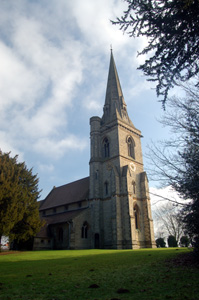
The church from the north-west January 2011
The foundation stone was laid by the Duchess of Bedford on 25th April 1854 and the event was described in an article on the church in the Northampton Mercury of 13th May 1854 by W.A. This was John Martin, librarian of Woburn Abbey, who wrote a series of articles on Bedfordshire churches in the Northampton Mercury in the 1840s and 1850s. He had written an earlier article about the deplorable state of the old church.
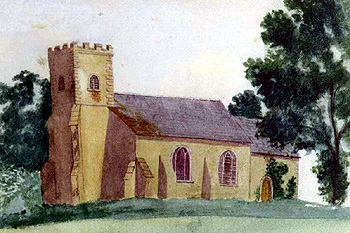
Segenhoe church in 1865 by an unknown artist
"This as little resembles a building for the Church of England as any we have seen in the county". These were the words we used, alas nearly ten years ago, little dreaming of the happy change we are now endeavouring to relate".
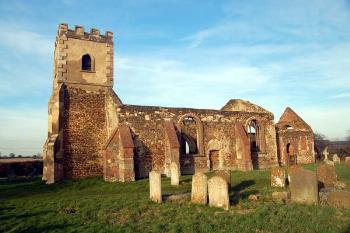
Segenhoe church from the south February 2007
"The building, never worthy of preservation, had become so dilapidated that repairs were absolutely necessary to sustain the fabric such as it is. Owing to the good sense of the churchwarden it was resolved to have a new building in a more convenient site, and capable of accommodating a larger congregation".
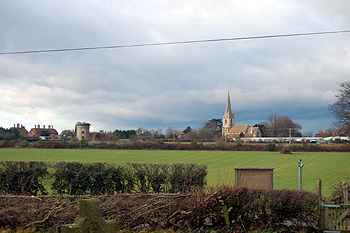
View of the new church from the old January 2012
"The foundation stone of the new building was laid by the Duchess of Bedford on Tuesday 25th, amid a numerous attendance of parishioners, the neighbouring gentry, and a very large assembly of the clergy".

Head on the east side of the north door January 2011
"Previous to the ceremony, Divine Service was performed in the old church, which could not accommodate the numerous applicants for admission".
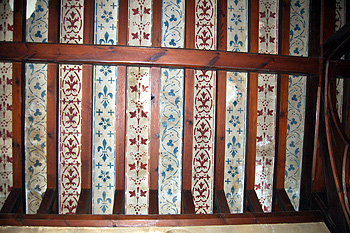
The roof of the north aisle June 2011
"The clergy, in their robes, gathered round the altar, and the service of the day was most impressively read by the incumbent, whom we were glad to see not turning his back on the holy table whilst repeating the creed, a practice, as it appears to us, most irreverent".
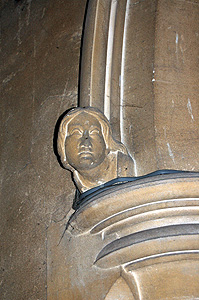
Head on the north side of the chancel arch June 2011
"After the service was concluded, a procession was formed by the clergy followed by the laity to the new site, chanting, in their progress, psalms appropriately selected for the occasion".
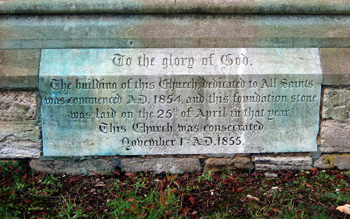
Foundation stone at the east end of the chancel January 2011
"When all had been properly arranged, the service for the occasion was read by the Vicar, the Rev. Charles Bentinck, and, at the proper moment the stone was lowered to its place into a bed of mortar which had been most skilfully prepared by the noble lady".
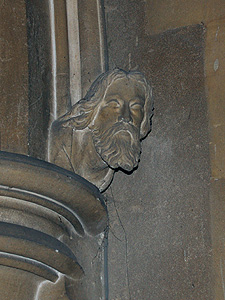
Head on the south side of the chancel arch June 2011
"It was gratifying to witness the very general reverence which prevailed, during the whole ceremony, by all parties".
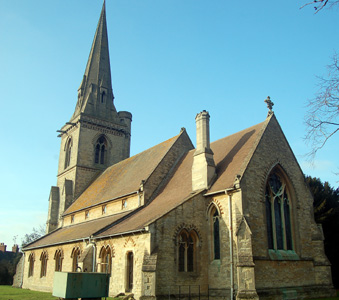
The church from the south-east January 2011
"The church is from a design by Mr. Scott, a guarantee that it will be rightly and ecclesiastically constructed. The period he has chosen, Early Decorated. The material, principally stone. The funds have been fairly met by the inhabitants, and considering there are many Dissenters in the parish, this speaks well for a liberal feeling towards England's church, not very frequently seen on these appeals. The funds have, however, been materially increased by the noble patron of the living [the Duke of Bedford, Martin's employer], whose absence on the occasion, from indisposition, was the only drawback to the general felicity. It must be remembered also, that he has already built the parsonage house, and another for a curate, in the adjoining village [Husborne Crawley], attached to this living".
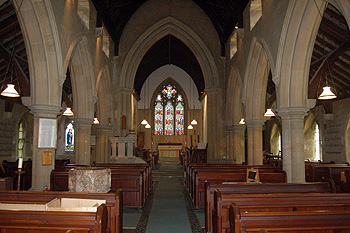
The interior looking east June 2011
"At present we hear that the funds are insufficient for the spire, which will be an object of pleasant contemplation for many miles around [as, indeed, it is]. That must be left as in former days, to the successors of those who have so worthily raised funds for the present purpose".

The interior looking west June 2011
"They" says the eloquent preacher [The Alabaster Box of Ointment, a sermon by F. D. Maurice M .A., preacher of Lincoln's Inn] "thought it no waste of time to be years in raising these buildings to him; if it were centuries, yet it was to one who is the same yesterday, to-day, and for ever, that they were rendering their homage, and it signified nothing whether they should see the completion of their work, for because He lived, they would live also, and they trusted that He would be the refuge of their children from generation to generation, as He had been to others".

The north door June 2011
"The collection on the ground amounted to upwards of £80". By the time the church was consecrated the Duke had contributed an additional £250. The spire was thus built at the same time as the rest of the church.

The tower and spire January 2011
Most of the structural history of the church can be found in detail in Bedfordshire Historical Record Society Volume number 77 of 1998 Bedfordshire Churches in the Nineteenth Century: Part II: Parishes H to R put together by former County Archivist Chris Pickford from numerous sources some held by Bedfordshire & Luton Archives & Records Service and some held elsewhere or published.
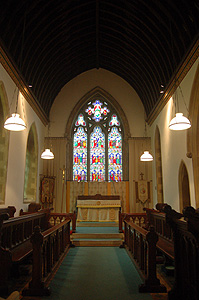
The chancel looking east June 2011
The completed church was consecrated on 1st November 1855. It is a large building, late 13th century in style, with a chancel and organ chamber, north and south aisles, nave, north porch and west tower and spire.
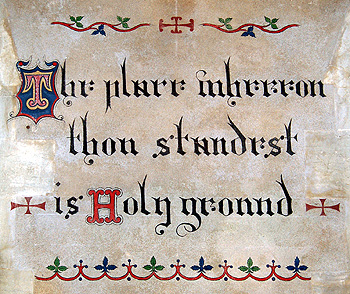
Third inscription from the east in the south aisle June 2011
Inside, it had painted texts in black letters on the walls. The capitals were picked out in red, the initial capitals in red, blue and gold. The texts survive.
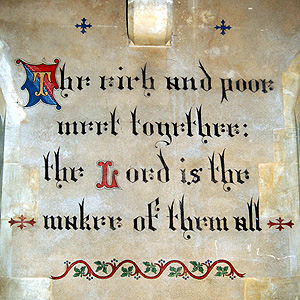
Westernmost inscription in the south aisle June 2011
The pulpit was of Bath stone pulpit with serpentine columns. The interior also has the original Minton tiles by Thomas Potter on the floor. The organ by J.W. Walker is also original.
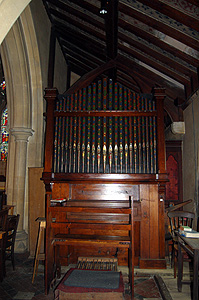
The organ at the east end of the south aisle June 2011
The stained glass in the east window, by Wailes of Newcastle was installed around the time the church was consecrated. Stained glass in the west window was installed around the same time and that in the chancel south window in 1865.

The east window June 2011
To begin with the font used was the one brought from Segenhoe. After the new church opened the old church was retained as a mortuary chapel. The new church did not have a burial ground and the churchyard at Segenhoe remained in use.